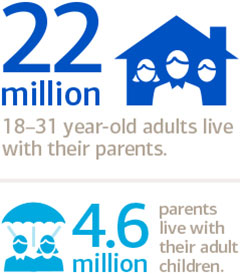
En español | When an extended family lives together, you need a plan to keep everyone happy.
In no time at all, it seemed, Ivy Vann and Hugh Beyer went from being empty nesters to having their nest overflowing with family members. When Hugh’s father died, the couple invited his mom, Molly, to come live with them. A few years later, their son and his wife moved into an apartment on the third floor of the family’s large Victorian home in New Hampshire. “They thought they would stay for two weeks,” Vann says, “but it’s been a year and they’re still here.”

Sources: AARP, 2012; PEW Research Center, August 2013.
The Vann/Beyer family is by no means an isolated case. The well-publicized boomerang phenomenon—adult children returning to live with their parents—is running headlong into another trend: Parachuting parents. Between 2008 and 2011, the number of parents living with an adult child climbed nearly 14% to 4.6 million, according to AARP. That’s in addition to the nearly 22 million adults between the ages of 18 and 31 now living with their parents, according to the Pew Research Center.
Like many families, the Vann/Beyers say they couldn’t be happier being surrounded by people they love. Yet, even in the best cases, multigenerational homes pose financial and social challenges that are best addressed at the outset, says Bill Hunter, director of Personal Retirement Strategies and Solutions for Bank of America Merrill Lynch. “Often, the desire to spend time with family is just one motivation—there’s also the need for financial support, or caregiving,” says Hunter. To help ensure your happiness—and theirs—consider these things:
The local scene
You may be willing to trade a little privacy for the benefits of having the gang under one roof, but will they all be happy in your home? Your kids will likely be pretty self-sufficient and able to address their own needs, but parents may be a different story.
“The typical home is designed for families and for commuting to school and work, but an aging parent may face boredom, isolation and lack of resources,” notes David Baxter, senior vice president of the research and consulting company Age Wave. “Consider availability of health care services, transportation, and whether your parents will be able to easily visit friends,” he says. “Don’t just ask yourself what your day will be like with your parents in your home—ask what their day will be like.”
Is your house a tight fit?
If the old homestead doesn’t fit your needs, an addition or even a new, larger house that suits the entire family may be the solution. Either fix may require a loan. “If you decide to remain in your house, this would be a good time to have a serious talk about how long you plan to stay there, as that could affect the type of loan that ends up being the best solution for you,” notes Kathy Ciaffa, director of pricing and products at Global Wealth & Investment Management standard residential real estate. And if you decide to purchase a new house, you might look into approaches that let you put little or no money down to avoid selling well-performing investments or incurring capital gains taxes, she says.
Should you charge rent?
Serving as landlord can be tricky, particularly when it comes to your adult kids. If you plan to charge rent for an extended stay, you may avoid raising hackles by being open about your own costs, and why and how much you expect them to contribute.
If they’ve never owned a home they may not realize how high such expenses as maintenance, insurance, mortgage payments and property taxes can be. Decide early which costs adult children will chip in on, Baxter recommends. They may help with such basics as food and general living expenses or even a renovation project. The Vann/Beyers, for example, agreed that Molly would pay to renovate the bedroom and bathroom to help her live comfortably.
What if circumstances change?
Think about current out-of-pocket costs as well as what might be in store down the road, Hunter says. “Even a self-sufficient parent may need some at-home care in a few years,” he explains. “At some point you may also need to modify your home, such as adding a ramp or railings.”
Three questions to ask your financial professional
1) How can we free up money for the added expenses of a multigenerational home?
2) What are our options in paying for alterations to our house?
3) With a parent living with us, what future costs should we be anticipating?
But even considering these expenses, combining households with aging parents may be more economical than other options, such as assisted living and nursing care facilities. The national average daily rate for a private room in a nursing home is $248, according to MetLife research.
“Ideally, you’ll live together comfortably as one big happy family, but you don’t always know what life has in store, so put together a contingency plan,” Hunter says. The sweetheart deal on rent you gave your son while he was looking for a job might need to be revised now that he’s found work and is earning a steady paycheck.
Becoming familiar with home health aide services and assisted-living facilities in your area is also a good idea, in case a parent’s health takes a turn for the worse. Keep in mind that some supplemental Medicare policies have six-month residency requirements, which means that the parent may not be covered immediately after a move to a new state. Long-term-care policies also vary. Some may compensate family members serving as caregivers, while others cover only institutional care.
Circumstances changed for the Vann/Beyer family recently, as well. When Molly was diagnosed with Parkinson’s a year ago, Ivy Vann gave up her part-time job to focus on her needs. Vann emphasizes the importance of having the right financial resources to ease the strain. “Money can’t buy love, but it sure can buy a housekeeper, the caretaking help you need and the wherewithal to create a living space appropriate for your loved one,” she says.
Learn more and take action
Today, it’s becoming increasingly common for parents, adult children and grandchildren to live together. Resources available at merrilledge.com can help you prepare for living in a multigenerational household.